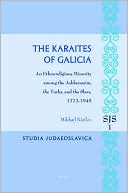List Books » The Karaites of Galicia: An Ethnoreligious Minority Among the Ashkenazim, the Turks, and the Slavs, 1772-1945
Category Books
- Fiction Books & Literature
- Graphic Novels
- Horror
- Mystery & Crime
- Poetry
- Romance Books
- Science Fiction & Fantasy
- Thrillers
- Westerns
- Ages 0-2
- Ages 3-5
- Ages 6-8
- Ages 9-12
- Teens
- Children's Books
- African Americans
- Antiques & Collectibles
- Art, Architecture & Photography
- Bibles & Bible Studies
- Biography
- Business Books
- Christianity
- Computer Books & Technology Books
- Cookbooks, Food & Wine
- Crafts & Hobbies Books
- Education & Teaching
- Engineering
- Entertainment
- Foreign Languages
- Game Books
- Gay & Lesbian
- Health Books, Diet & Fitness Books
- History
- Home & Garden
- Humor Books
- Judaism & Judaica
- Law
- Medical Books
- New Age & Spirituality
- Nonfiction
- Parenting & Family
- Pets
- Philosophy
- Political Books & Current Events Books
- Psychology & Psychotherapy
- Reference
- Religion Books
- Science & Nature
- Self Improvement
- Sex & Relationships
- Social Sciences
- Sports & Adventure
- Study Guides & Test Prep
- Travel
- True Crime
- Weddings
- Women's Studies
The Karaites of Galicia: An Ethnoreligious Minority Among the Ashkenazim, the Turks, and the Slavs, 1772-1945 »

Authors: Mikhail Kizilov
ISBN-13: 9789004166028, ISBN-10: 9004166025
Format: Hardcover
Publisher: Brill Academic Publishers, Inc.
Date Published: December 2008
Edition: (Non-applicable)
Author Biography: Mikhail Kizilov
Mikhail Kizilov, D.Phil (2007) in Modern History, University of Oxford, is a Kreitmann Fellow at Ben Gurion University of the Negev (Beer Sheva). He has more than 60 publications on Karaite, Crimean, Khazar, and Jewish history in the English, Russian, German, and Hebrew languages including The Karaites Through the Travelers' Eyes (New York, 2003).
Book Synopsis
Drawing on sources in original languages, the book offers the first comprehensive study of the history, ethnography and convoluted ethnic identity of the Galician Karaites, a non-Talmudic Turkic-speaking minority of Jewish scripturalists.
Table of Contents
List of Abbreviations ix
List of Illustrations xi
Acknowledgements xv
Chapter 1 Introduction to the Study and the History of Karaism 1
1.1 The Topicality of Studying the Galician Karaites as a Vanishing Ethnic Minority 1
1.2 Literature Survey 13
1.3 Methodological Difficulties, Sources, and Objectives of the Study 19
1.4 The System of Transliteration 28
1.5 Outline of the History of the Galician Karaite Community Prior to 1772 30
Chapter 2 The Karaites in Austrian Galicia: The Community as Seen from Outside 55
2.1 The Karaites and Toleranzpolitik 55
2.2 The Karaites as the "Exemplary Jews" of Austria 71
2.3 The Karaites and the Royal Family of Austria 81
Chapter 3 The Karaites in Austrian Galicia, Their History and Culture: The Community as Seen from Within 89
3.1 Halicz 89
3.2 Kukizow 123
3.3 Lwow-Lemberg and Its Role in the Life of the Galician Karaites from 1772 to 1918 131
Chapter 4 The Galician Karaites, Their Language, Customs, and Traditions: The Community as Seen from an Ethnographic Perspective 133
4.1 Religio-Ethnographic Customs and Traditions 133
4.2 Karaim, a Turko-Judeo-Slavic Language: History, Literature, and Folklore 154
4.3 The Crimean Karaites and Their Impact on the Religious and Everyday Life of the Galician Community 180
Chapter 5 The Karaites and Their Neighbours: Relations with the Christian Population and with the Rabbanite Jews 191
5.1 The Karaites and the Slavic Population (Poles and Ruthenians) 191
5.2 The Karaites and the Talmudic Jews 202
Chapter 6 Karaites in Polish Galicia between the Two World Wars 235
6.1 General State of the Community after World War I 235
6.2 Interwar Hazzanim,Isaac Abrahamowicz, and the Conflicts of the 1920s and Early 1930s 250
6.3 The Karaites and Their Ethnic Neighbours 257
Chapter 7 Khazar Theory vs. Racial Anthropology: Interwar Turkicization of the Galician Karaites and Its Outcome during World War II 265
7.1 Seraja Szapszal's Visit to Halicz in 1929 265
7.2 Seraja Szapszal's Reformist Activity of the 1930s 268
7.3 The Visit of Corrado Gini's Anthropological Expedition and Its Impact on the Development of Szapszal's Turkic Theory 277
7.4 Implementation of Szapszal's Turkic Doctrine in Halicz and Its Outcome 287
7.5 The Karaites of Halicz during the Second World War and the Holocaust 294
Chapter 8 The Galician Karaites after 1945 303
8.1 Decline of the Galician Community after the Second World War 303
8.2 The Collapse of the Soviet Union and the Last of the Galician Mohicans 314
8.3 The Galician Karaite Community and Its Cultural Heritage Today 318
Conclusion The Historical Fate, the Past, and the Future of the Karaite Community in Eastern Europe 323
Glossary 343
Bibliography 345
Appendices 377
Index 409
Plates 417
Subjects
 Judaism & Judaica
Judaism & Judaica  Movements & Sects - Judaism
Movements & Sects - JudaismJudaism & Judaica
 Movements & Sects - Judaism
Movements & Sects - Judaism  Jewish Movements & Sects - General & Miscellaneous
Jewish Movements & Sects - General & MiscellaneousReligion Books
 Judaism & Judaica
Judaism & Judaica  Movements & Sects - Judaism
Movements & Sects - JudaismChristianity
 Christianity
Christianity  All Religion
All ReligionNonfiction
 Religion
Religion  All Religion
All ReligionReligion Books
 Christianity
Christianity  All Religion
All Religion
